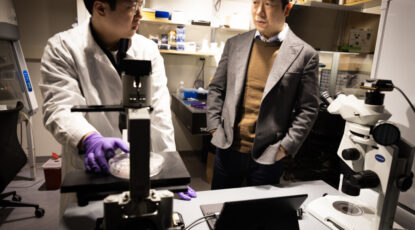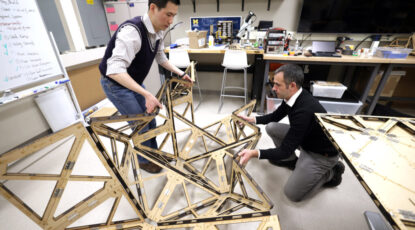Too much screen time? U-M pioneers digital wellness program for youths

Addiction, cyberbullying, eating disorders, anxiety, and other mental health issues caused by problematic digital practices and an increase in screen time are some of the themes of a new and unique U-M interprofessional Peer-to-Peer Digital Wellness class.
-
New Michigan poverty map identifies needs related to education, food insecurity, affordable housing
A new data map showcasing diverse indicators of poverty and well-being throughout Michigan highlights the key challenges confronting residents in different parts of the state and suggests interventions for the state’s most critical needs. The latest map features 2021 data from the Census Bureau’s American Community Survey.
-
Michigan Minds podcast: U-M President Ono shares vision on democracy, engagement
UM’s vision to be the defining public university outlines four areas where the university will make dramatic and focused impact: life-changing education; human health and well-being; democracy, civic and global engagement; and climate action, sustainability and environmental justice.
-
Could riding older school buses hinder student performance?
Students who ride newer, cleaner-air buses to school have improved academic performance, according to a U-M study that linked school bus funding information with standardized test scores and found improvements in reading/language arts and math scores when the oldest buses were replaced with newer vehicles.
-
Human stem cells coaxed to mimic the very early central nervous system
The first stem cell culture method that produces a full model of the early stages of the human central nervous system has been developed by a team of engineers and biologists at U-M, the Weizmann Institute of Science, and the University of Pennsylvania. The model, which resembles all three sections of the embryonic brain and spinal cord, could shed light on developmental brain diseases.
-
Bridge in a box: Unlocking origami’s power to produce load-bearing structures
For the first time, load-bearing structures like bridges and shelters can be made with origami modules — versatile components that can fold compactly and adapt into different shapes. It’s an advance that could enable communities to quickly rebuild facilities and systems damaged or destroyed during natural disasters, or allow for construction in places that were previously considered impractical, including outer space.
-
Futuristic technology reveals secrets in ancient Vesuvius Scrolls
When Italy’s Mount Vesuvius erupted in AD 79, it buried the palatial villa of Lucius Calpurnius Piso Caesoninus, Julius Caesar’s father-in-law. These black and brittle papyri may look like charred croissants, but U-M classicist Richard Janko believes they contain lost masterpieces of literature, history, and philosophy.
Columns
-
President's Message
AI’s promise for teaching and learning
As U-M customizes Gen AI tools on campus, President Ono focuses on best practices defined by accessibility, privacy, integrity. -
Editor's Blog
Something old, something new
Who's ready for an excellent adventure? Just keep an eye peeled for the (virtual) hot lava. -
Climate Blue
Order from disorder
Ricky Rood explains the organizing principles behind weather, which is how we feel climate. -
Health Yourself
Getting a leg up on sciatica and piriformis syndrome
Victor Katch compares and contrasts sciatica and piriformis syndrome and explains how to ease that pain in your butt.
The Art Show
Founded in 1990 with a single theatre workshop, the Prison Creative Arts Project (PCAP) is a program of U-M’s Residential College. Courses serve as gateways for undergraduate participation in prison arts workshops and provide academic training in issues surrounding incarceration and practical skills in the arts. The program’s Annual Exhibition of Artists in Michigan Prisons (“the art show”) is one of the largest exhibits of artwork by incarcerated artists in the world. The annual exhibition, free to the public, is presented with support from the Michigan Arts and Culture Council. It runs through April 2 at the Duderstadt Gallery. (Click on the images to enlarge. Images are courtesy of PCAP.) Learn more about PCAP.



















